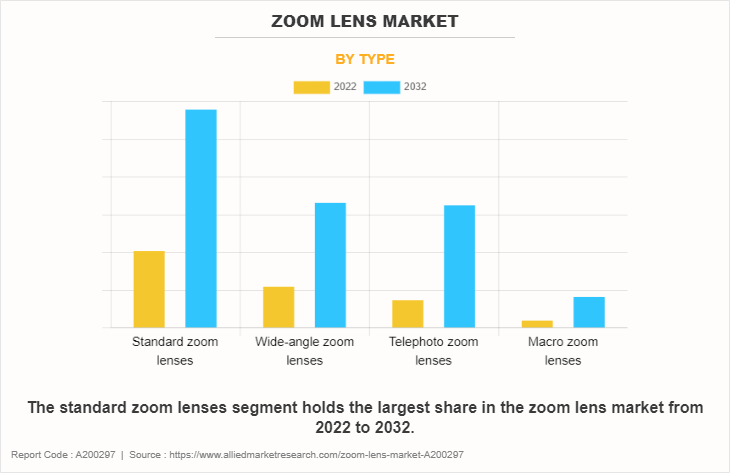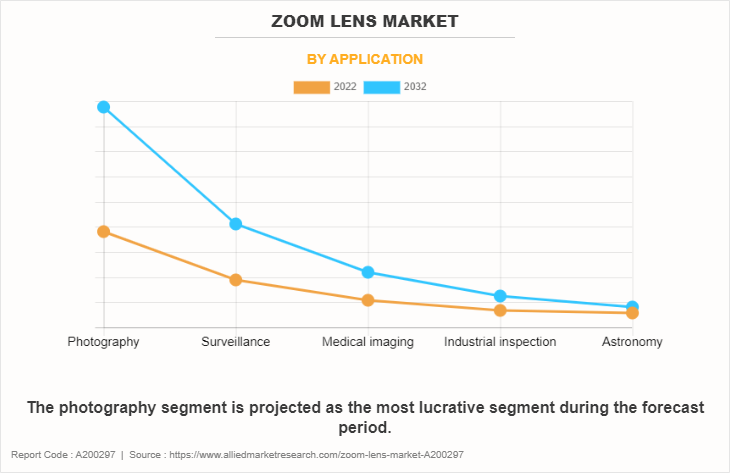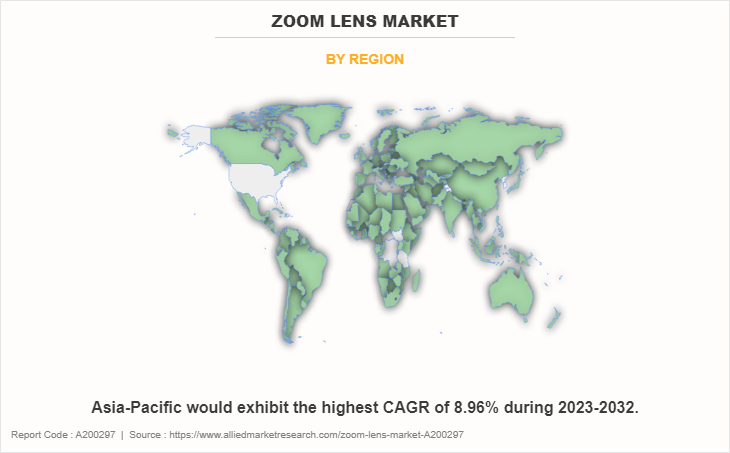Zoom Lens Market Research, 2032
The global zoom lens market was valued at $4 billion in 2022, and is projected to reach $8.6 billion by 2032, growing at a CAGR of 8% from 2023 to 2032.
A zoom lens is a type of camera lens that provides individuals with the ability to adjust the lens's focal length. This adjustment allows the person using the lens to change the magnification of the subject being photographed without any physical movement closer to or farther away from the subject. In simpler terms, the lens permits users to zoom in to capture subjects at a distance or zoom out to capture a wider view. These lenses offer versatility by including a range of focal lengths within a single lens, setting them apart from prime lenses that possess a fixed focal length. People often use zoom lenses across various photography genres, including landscapes, portraits, sports, and wildlife, where the capability to swiftly modify framing and composition is useful.
Zoom lenses are commonly found in various types of cameras, including digital single-lens reflex (DSLR) cameras, mirrorless cameras, and camcorders. These lenses provide a range of focal lengths, usually indicated by two values (for example, 18-55mm or 70-200mm), which indicate the shortest and longest focal lengths the lens attains. This range is termed the lens's "zoom range".
One specialized type of zoom lens is the telephoto lens, equipped with advanced zooming optics. Telephoto lenses enhance a photographer's ability to focus on distant subjects, resulting in sharp and detailed images that would otherwise be challenging to capture. These lenses are especially valuable when shooting subjects at a distance, such as wildlife or sports events. Whether it's a standard zoom lens or a specialized telephoto zoom, the versatility and adaptability of zoom lenses make them indispensable tools for photographers seeking flexibility in their creative endeavors.

Segment Overview
The zoom lens market is segmented into Type and Application.

By type, the zoom lens market is categorized into standard zoom lenses, wide-angle zoom lenses, telephoto zoom lenses, and macro zoom lenses.

By application, the zoom lens industry is fragmented into photography, surveillance, medical imaging, industrial inspection, and astronomy.

By region, the zoom lens industry is analyzed across North America (U.S., Canada, and Mexico), Europe (UK, Germany, France, and rest of Europe), Asia-Pacific (China, Japan, India, South Korea, and rest of Asia-Pacific) and LAMEA (Latin America, Middle East, and Africa).
Country-wise, the U.S. has acquired a prime zoom lens market share in the North American region and is expected to grow at a significant CAGR during the forecast period of 2023-2032. This dominant position can be attributed to several key factors. Firstly, the country's robust photography and videography industry, driven by professionals, hobbyists, and content creators, fuels high demand for quality lenses. Additionally, the U.S. boasts a thriving e-commerce ecosystem, making it easy for consumers to access and purchase zoom lenses online. Furthermore, ongoing technological innovation and a strong presence of lens manufacturers contribute to the country's market leadership. With these factors in play, the U.S. is expected to maintain its leading position and experience significant growth at a CAGR during the forecast period of 2023-2032.
In Europe, the UK emerged as the dominant player in terms of revenue share in the zoom lens market in 2022, and this trend is expected to continue during the forecast period. This remarkable position can be attributed to a combination of factors, including a robust photography and videography community, a strong emphasis on technology and innovation, and a thriving e-commerce ecosystem. With a growing demand for versatile zoom lenses driven by both professionals and enthusiasts, the UK's prominence in the market is set to endure, making it a pivotal hub for zoom lens sales and innovation in Europe.
In the Asia-Pacific region, China is anticipated to become a prominent market for the zoom lens industry. This prominence can be attributed to several factors. Firstly, the country's burgeoning middle class is driving a significant surge in demand for digital cameras and lenses, including zoom lenses, as more consumers engage in photography and content creation. Additionally, China's embrace of e-commerce platforms and the widespread popularity of smartphone photography create an ideal environment for zoom lens manufacturers to reach a vast and diverse consumer base. With a growing emphasis on visual storytelling and photography, China's prominence in the market is expected to continue to expand in the coming years, making it a pivotal hub for the zoom lens industry in the Asia-Pacific region.
In the LAMEA region, Latin America dominated the zoom lens market size in terms of revenue in 2022. This dominance can be attributed to several factors. Firstly, Latin America's vibrant photography culture and the increasing popularity of photography as a hobby and profession have driven significant demand for zoom lenses. Additionally, rising disposable incomes in some Latin American countries have allowed consumers to invest in high-quality photography equipment, including zoom lenses. Moreover, the region's dynamic landscapes, rich cultural events, and diverse environments create a demand for versatile lenses, making Latin America a natural market leader. With a growing interest in photography and improving economic conditions, Latin America's prominence in the zoom lens market is poised to continue in the coming years.
Major global events, ranging from international sports tournaments such as the Olympics and FIFA World Cup to significant cultural celebrations and festivals, have a remarkable impact on demand for zoom lenses. These events gather people from across the globe and create moments of shared excitement & emotion that individuals want to capture in high-quality photographs. Zoom lenses are crucial tools for photographers and enthusiasts looking to get close-up shots of athletes in action, artists performing on stage, or intricate details of cultural displays. The versatility of zoom lenses, allowing users to adjust focal lengths to capture distant and nearby subjects, makes them essential for seizing the essence of these dynamic and short-lived moments. As a result, the surge in demand for zoom lenses during such events becomes a key driver in the photography equipment market, responding to the universal desire to document and preserve the extraordinary experiences that global events offer.
However, the size and weight of these lenses restrain the market growth. Particularly, advanced zoom lenses, especially those featuring extensive focal ranges and wide apertures, often come with the downside of being bulky and heavy. This could pose a challenge for photographers who emphasize the convenience of portability and easy handling. The bulkiness and weight of these lenses impede photographers from carrying and maneuvering their equipment comfortably, affecting their ability to capture spontaneous moments while on the move or during prolonged shooting sessions. Consequently, photographers in search of lightweight and flexible gear might encounter restrictions when considering high-performance zoom lenses. This might prompt them to explore alternative choices in the market that better suit their preferences for mobility.
Despite this restraint, an opportunity factor within the zoom lens market emerges through technological convergence. This involves integrating zoom lens technology into new sectors, such as smartphones and drones. This thoughtful combination creates demand for zoom lenses and stimulates innovation. Smartphones have become an increasingly important tool for photography. Incorporating zoom lens features into smartphone’s compact designs could significantly improve phones photographic versatility. This enhancement makes smartphones even more appealing to consumers who want to capture high-quality photos on the go. As drones continue to rise in popularity, the integration of advanced zoom lenses into these unmanned aerial vehicles holds the potential to unlock exciting avenues in the fields of aerial photography and surveillance applications. Zoom lenses have become valuable tools for businesses and organizations that need to collect data or monitor large areas. The convergence of zoom lens technology with these emerging sectors has not only expanded the market for zoom lenses, however, has also stimulated innovation. Manufacturers work to enhance performance and miniaturize lenses for seamless integration. This effort leads to new and innovative zoom lenses that cater to the needs of a variety of users. Overall, technological convergence represents a major zoom lens market opportunity. It helps to address evolving consumer needs and revolutionize industries reliant on advanced imaging capabilities.
Top Impacting Factors
The demand for high-quality images and videos has led to a surge in demand for zoom lenses. The surge in utilization of social media and online sharing platforms have played a significant role in driving this demand. The rise of vlogging and live streaming has also led to a greater demand for zoom lenses, as they enable creators to capture high-quality videos of themselves and their surroundings. However, the high cost of zoom lenses acts as a significant constraint, potentially discouraging potential buyers from adopting these lenses. On the other hand, the aging camera upgrade cycle presents an opportunity for manufacturers specializing in zoom lenses. As photographers and videographers opt for equipment upgrades to keep up with technological progress, they actively seek enhanced optical performance and greater versatility to align seamlessly with their upgraded camera systems.
Competitive Analysis
The zoom lens market outlook report highlights the highly competitive nature of the market, owing to the strong presence of existing vendors. Vendors with extensive technical and financial resources are expected to gain a competitive advantage over their counterparts by effectively addressing market demands. The competitive environment in this market is expected to increase as product launches, expansions, acquisitions, and market penetration strategies adopted by key vendors increase. Competitive analysis and profiles of the major zoom lens market players that have been provided in the report include Canon Inc., Nikon Corporation, FUJIFILM Corporation, Sony Corporation, Carl Zeiss AG, Tamron Co., Ltd., Cooke Optics, Kenko Tokina Co., Ltd., ARRI AG., and Angénieux.
Key Developments/ Strategies
According to the latest zoom lens market forecast, Sony Corporation, Canon Inc., Nikon Corporation, Tamron Co., Ltd., and Carl Zeiss AG are the top players in this market. Top market players have adopted various strategies, such as product launches, expansions, acquisitions, and market penetration to expand their foothold in the zoom lens market.
In August 2023, Sony introduced the Alpha E-mount series with the FE 70-200mm F4 Macro G OSS II telephoto zoom lens. According to the company, this lens is designed for photography enthusiasts and professionals in search of versatile capabilities. Covering focal lengths from 70mm to 200mm with a maximum aperture of F4, the lens caters to a diverse array of shooting scenarios.
In April 2023, Canon launched two lenses for its mirrorless cameras. The lenses are a part of the company's Flex Zoom Lens series of EF cinema lenses. This includes the CN-E14-35mm T1.7 L S wide angle zoom lens and CN-E31.5-95mm T1.7 L S telephoto zoom lens.
In May 2022, Tamron Co., Ltd. launched three models of an industry-standard 29mm compact-size fixed-focal lenses for machine vision, compatible with 2/3” imagers and 8-mega pixel high resolution, Model MA23F12V (focal length 12mm), MA23F16V (16mm), and MA23F50V (50mm) the new MA23F Series of 2/3” 8-mega pixel machine-vision lenses offers a total of six different focal lengths ideal for a wide range of applications.
Key Benefits For Stakeholders
- This report provides a quantitative analysis of the market segments, current trends, estimations, and dynamics of the zoom lens market analysis from 2022 to 2032 to identify the prevailing market opportunities.
- The market research is offered along with information related to key drivers, restraints, and opportunities.
- Porter's five forces analysis highlights the potency of buyers and suppliers to enable stakeholders make profit-oriented business decisions and strengthen their supplier-buyer network.
- In-depth analysis of the zoom lens market segmentation assists to determine the prevailing market opportunities.
- Major countries in each region are mapped according to their revenue contribution to the global market.
- Market player positioning facilitates benchmarking and provides a clear understanding of the present position of the market players.
- The report includes the analysis of the regional as well as global zoom lens market trends, key players, market segments, application areas, and zoom lens market growth strategies.
Zoom Lens Market Report Highlights
| Aspects | Details |
| Market Size By 2032 | USD 8.6 billion |
| Growth Rate | CAGR of 8% |
| Forecast period | 2022 - 2032 |
| Report Pages | 220 |
| By Type |
|
| By Application |
|
| By Region |
|
| Key Market Players | Kenko Tokina Co., Ltd., FUJIFILM Holdings Corporation, Canon Inc., Tamron Co., Ltd., Angénieux, Nikon Corporation., Sony Corporation, Carl Zeiss AG, Cooke Optics, ARRI AG. |
Analyst Review
The zoom lens market is projected to experience significant growth during the forecast period. In the ever-evolving landscape of technology and consumer preferences, the zoom lens market is anticipated to undergo a substantial growth phase during the forecast period. This surge is attributed to the heightened demand for high-quality imaging solutions, which has gained importance driven by the widespread growth of activities such as content creation, virtual communication, and remote collaboration. The built-in flexibility exhibited by zoom lenses allows them to capture small, intricate details and expansive wide views, which has firmly established its significance across a diverse range of domains. Particularly, from the realms of professional photography and videography to the domains of telemedicine and online events, these lenses have found widespread utility.
Moreover, the incorporation of advanced technologies, comprising elements such as image stabilization and improved autofocus systems, has significantly enhanced the ease of use and accessibility of zoom lenses. This technological enhancement has played a crucial part in encouraging zoom lens adoption across different industries. As consumer preferences continue to change, it is clear that the zoom lens market is ready to enter a phase of significant growth and change.
Some of the key players profiled in the study include Canon Inc., Nikon Corporation, FUJIFILM Corporation, Sony Corporation, Carl Zeiss AG, Tamron Co., Ltd., Cooke Optics, Kenko Tokina Co., Ltd., ARRI AG., and Angénieux. These players have adopted various strategies to increase their market penetration and strengthen their position in the zoom lens industry.
The Zoom Lens Market is expected to grow at a CAGR of 8.0% during the period of 2023 to 2032.
Photography is the leading application of Zoom Lens Market.
North America is the largest regional market for Zoom Lens.
The industry size of Zoom Lens is estimated to be $4,000.0 million in 2022.
The top companies holding significant market share in the Zoom Lens industry include Sony Corporation, Canon Inc., Nikon Corporation, Tamron Co., Ltd., and Carl Zeiss AG.
Loading Table Of Content...
Loading Research Methodology...


